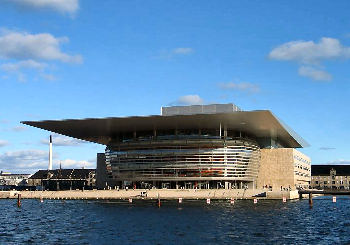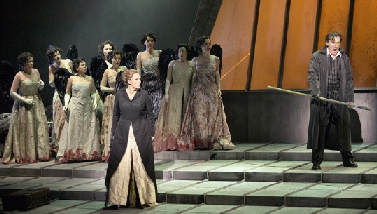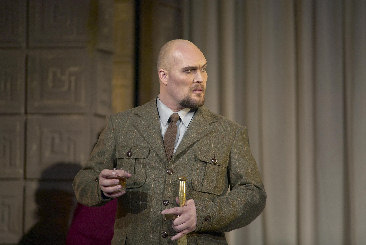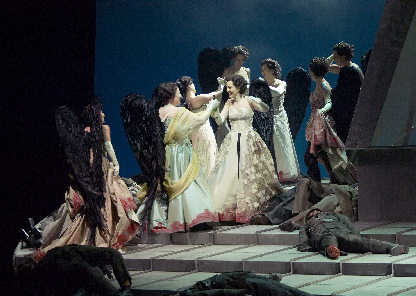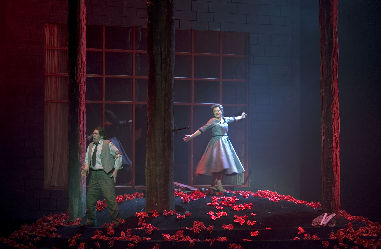|
Editor:
Marc Bridle
Webmaster: Len Mullenger
|
Seen and Heard International
Opera Review
R.Wagner,
Die Walküre: Soloists, Det Kongelige Kapel,
Michael Schønwandt, Operaen, Copenhagen 26.12.2005
(BK)
The New Copenhagen
Opera House Principals:
Brunnhilde, Wotan and the Valkyries
Brisk winds and a heavy snowfall made the journey by water-taxi to Copenhagen's new opera house more suited to The Dutchman than Die Walküre, but Viking heritage held firm. And as it happened, having a 'Steerswoman' to take us through the harbour's choppy waters proved a particularly apt prelude to the first part of 'Brünnhilde's Ring,' as Kasper Bech Holten calls it.
Royal Danish Opera and Ballet's new home
opened in January of this year and must rank as one of Denmark’s
most innovative buildings. It was completed in only three
years to a design by Henning Larsen and was a gift to the
nation from the shipping magnate Maersk McKinney Møller.
Thanks to this remarkable act - the overall cost was 430 million
euros or 2.5 billion Danish Kroner - the company now has world-class
facilities with 1700 seats in the main auditorium and an orchestra
pit for 110 players.
Kasper Bech Holten is a real phenomenon. At 33 he must be one of the youngest Artistic Directors of a major company anywhere in the world (his web site is here) and he has racked up an impressive list of achievements so far. His vision of the 'Ring' is summed up in these extracts from his web log:
"Along with Brünnhilde we journey through the 1920s and 1930s in Das Rheingold, in which the great ideological structures are raised, until we reach the 1950s in Die Walküre when the Cold War has frozen those structures into fortresses ... Siegfried brings us to 1968 when the eponymous young hero naively rebels against his father's rules and ideals until the fin-de-siècle joy he expresses in Götterdämmerung comes to an abrupt end in a clash with pure evil of the type seen in Bosnia or Rwanda ... "We also tell the story of a woman with such a powerful Electra complex that it prevents her from freeing herself from her father's influence until far too late."
Brünnhilde has the Electra complex of course. I understand that she appears briefly in Das Rheingold and as Holten puts it, "we start with the end rather than the beginning, and the entire Ring is experienced as one big flashback."
Stephen Milling as Hunding
There is certainly 'girl power' in this Walküre, but to definite purpose. In Act I, Sieglinde's advances to Siegmund are made very clear indeed and it is she who pulls the sword from the ash tree. Fricka holds her own strongly in Valhalla since her Nordic dignity and status is emphasised, rather than her more customary portrayal as a ranting harpy. Hunding does not die in Act II either, but is sent off to kneel before Fricka as Wotan commands. Kasper Holten has restored to this Walküre the the Norse (rather than Teutonic) sagas' emphasis on gender equality for Gods and humans alike. Brünnhilde gives up her godliness herself in Act III - in the form of a live pigeon that flies away backstage - rather than meekly submitting to Wotan's will. This may very well be her 'Ring.'
The Valkyries
From this Nordic context, Holten's presentation
of the 'Ring' as a modern day history makes more sense than
many productions and portrays the text's timeless relevance
better than most. If Götterdämmerung for
example, uses Bosnia and Rwanda as its models, then Ragnaròk,
the sagas' description of the ending of all things, has happened
for some people already and there is no more a guarantee now
(than ever was or shall be) that the transition to a new order
will be smoother, better or more wahnfrei than in
the past. Human and godly folly - and human and godly
nobility for that matter - may be equally everlasting. To the best of my knowledge, Michael Schønwandt
is the only Danish conductor ever to have appeared at Bayreuth
and he clearly knows his Wagner. Apart from a slightly shaky
prelude to Act I, the orchestral playing was excellent throughout
and I have rarely heard Fricka's music in Act II sound so
luminous or beautiful.
The only disappointments in fact, were Poul Elming (Siegmund) and Gitta-Maria Sjöberg (Sieglinde) neither of whom were in the best of voice on this occasion. Stephen Milling's bass was formidable (as was his physical presence) and James Johnson - a slightly lighter toned Wotan than many - acquitted himself with sufficient dignity and vocal flexibility to provide a convincing characterisation. Susanna Resmark's Fricka (sung with a fine controlled low mezzo) partnered him admirably.
Competent Brünnhildes are rarities these days but Iréne Theorin is one of them. Trained in Gothenburg and the Opera Academy in Copenhagen, she was tutored by Birgit Nilsson, Ingrid Bjoner and Geoffrey Parsons and the training shows. With a good deal of Wagner singing to her credit already, hers is a firm voiced, powerful hoch-dramatisch soprano soon to be heard for a second time at Bayreuth (3rd Norn and Helmwige in this year's new Ring.) She was the icing on the cake for this splendid production.
Back to the Top Back to the Index Page |
| ||
|
||||



